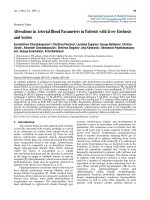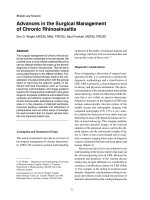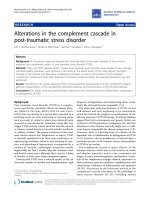Báo cáo y học: "Rituximab in lupus Robert Eisenberg." pdf
Bạn đang xem bản rút gọn của tài liệu. Xem và tải ngay bản đầy đủ của tài liệu tại đây (41.77 KB, 3 trang )
157
IL = interleukin; MHC = major histocompatibility complex; SLE = systemic lupus erythematosus.
Available online />Introduction: B cells in systemic lupus
erythematosus
A central feature of systemic lupus erythematosus (SLE) is
the loss of B-cell tolerance. At least some autoantibodies
from a limited spectrum of reactivities against mainly intra-
cellular antigens are usually present, and probably
account for some of the pathological manifestations.
Although the numbers of B cells in the peripheral blood
are often decreased, those that are present have abnormal
phenotypes indicative of activation [1].
In addition, substantial evidence from mouse models of
systemic autoimmunity clearly implicates the central role
of B cells [2]. In several spontaneous models, the
genetic abnormalities that cause the loss of tolerance
must be expressed in those B cells that become autoim-
mune [3]. A wide variety of single gene abnormalities
that are largely or solely expressed in B cells also leads
to lupus-like systemic autoimmunity, either by lack of
function through spontaneous mutations or knockout
transgenics, or through hyperexpression of exogenous
transgenes [4]. If B cells are removed from lupus models
by genetic manipulations or chronic antibody therapy,
the syndrome is largely suppressed, including T-cell
abnormalities [5].
Other studies in mice genetically without B cells also
implicate B cells in a number of immunoregulatory interac-
tions that go beyond their clear role as the precursor of
antibody forming cells [6]. B cells can regulate T cells,
dendritic cells and other B cells. They can produce a
variety of cytokines, including IL-4 and IL-10, and even can
differentiate into subtypes that secrete certain sets of
cytokines, analogous to T helper type 1 and T helper
type 2 cells [7]. B cells are superb antigen presenting
cells, since they can express MHC class II as well as co-
stimulatory molecules such as CD80 and CD86, and their
cell surface immunuoglobulin antigen receptor is ideal for
focusing and concentrating specific protein molecules [8].
Curiously, at present we do not know for certain what role
B cells play in human SLE [9]. Some clinical manifesta-
tions appear to be antibody mediated, such as hemolytic
anemia and glomerular inflammation, but the pathogenesis
of many of the aspects of the disease remains obscure,
and most of the disease-associated autoantibodies do not
appear to have a direct pathogenic role. The potential
immunopathogenic importance of B cells is implicated in
the occasional case reports of SLE patients that devel-
oped common variable immunodeficiency and showed
improvement in the manifestations of SLE concomitant
with loss of B-cell function [10].
Commentary
SLE
Rituximab in lupus
Robert Eisenberg
Division of Rheumatology, University of Pennsylvania, Philadelphia, Pennsylvania, USA
Corresponding author: Robert Eisenberg (e-mail: )
Received: 5 Mar 2003 Accepted: 17 Mar 2003 Published: 15 Apr 2003
Arthritis Res Ther 2003, 5:157-159 (DOI 10.1186/ar759)
© 2003 BioMed Central Ltd (Print ISSN 1478-6354; Online ISSN 1478-6362)
Abstract
B cells are essential to the development of systemic lupus erythematosus (SLE). The chimeric
monoclonal antibody rituximab depletes B cells by targeting the pan-B-cell surface marker CD20.
Preliminary experience with this agent in SLE and other autoimmune diseases has been encouraging.
Controlled trials in SLE will be necessary to determine whether rituximab is useful therapy in this
disease, and will teach us more about the roles of B cells in its pathogenesis.
Keywords: B cells, CD20, rituximab, systemic lupus erythematosus
158
Arthritis Research & Therapy Vol 5 No 4 Eisenberg
Rituximab and B-cell depletion
It was thus a reasonable hypothesis that removing B cells
in SLE might have a positive therapeutic effect [11]. The
availability of Rituxan
®
(rituximab) (Genentech, South San
Francisco, CA, USA) made it possible to test this hypothe-
sis [12]. Rituximab is a chimeric monoclonal antibody
reagent consisting of human IgG
1
and kappa constant
regions, and of mouse variable regions from a hybridoma
directed at human CD20. CD20 is a specific B-cell marker
present in all stages of B-cell development except the ear-
liest and the latest [13]. Its cell function is unknown
(CD20 knockout mice have no obvious B-cell deficits
[14]) but it is expressed at high levels, it does not shed or
endocytose when exposed to antibody, and it does not
exist in a soluble form [15]. These features predicted that
CD20 might be an excellent target for therapy directed at
B-cell malignancies. This in fact proved to be the case,
and rituximab was approved in 1997 for treatment of non-
Hodgkin B-cell lymphomas [12]. After four weekly intra-
venous doses, rituximab also depletes normal B cells from
the peripheral blood almost completely in most patients,
and this depletion persists for 6 months and more, well
beyond the persistence of the rituximab itself. Importantly,
the extent of depletion of B cells from peripheral lymphoid
organs is not known. However, serum immunoglobulins do
not fall substantially during treatment, and increased infec-
tions have not been found to be a complication.
After rituximab received Food and Drug Administration
approval for lymphoma, several investigators began trying
it in uncontrolled series of patients with a variety of autoim-
mune diseases. The hope was not only that the drug might
be therapeutically effective, but also that through monitor-
ing its use we would learn a great deal about the role of
B cells in the pathogenesis of these conditions. Encourag-
ing anecdotal reports have appeared for a potential
response to rituximab of patients with rheumatoid arthritis,
polymyositis/dermatomyositis, idiopathic thrombocyto-
penia purpura, essential mixed cryoglobulinemia, hemolytic
anemia, myasthenia gravis, Wegener’s granulomatosis,
and IgM-mediated neuropathy, as well as patients with
SLE [16–23]. This approach has recently received a major
impetus from the preliminary report of substantial efficacy
in a controlled trial in rheumatoid arthritis [24].
So what about SLE? A published experience with six
patients looked promising, as did a few individual anecdotes
[17]. A phase I trial from Looney and colleagues showed
improvement in certain subgroups in a post hoc analysis
[25]. Our own phase I trial also has examples of patients who
have improved clinically and who have decreased steroid
usage after treatment (unpublished data). The safety profile
has so far been good, as would have been predicted from
the extensive experience (over 300,000 patients) in individu-
als with B-cell malignancies, although it must not be forgot-
ten that rare cases of severe, fatal infusion reactions have
been reported [26]. Surprisingly, many of the SLE patients
developed human antichimeric antibody responses, perhaps
in part because they did not receive the full therapeutic dose
in the early dose-escalation period of the protocols.
At this point, it is essential that controlled trials be con-
ducted to determine for certain whether rituximab has a
clinically useful therapeutic effect in SLE. If efficacy could
be established for one particular manifestation, such as
renal disease or skin disease, or on the basis of overall
disease scores, it would add an important additional drug
to our approach to SLE in general. If rituximab permitted
substantially lower use of steroids or cytotoxics, particu-
larly cyclophosphamide, it would be a significant advance
in patient safety.
What can we expect with rituximab treatment of SLE? The
data so far indicate that autoantibodies, such as anti-DNA,
are not suppressed. This is in distinction to what has been
seen in the rheumatoid population, where both rheumatoid
factors and anticyclic citrullinated peptide antibodies
decreased [27]. Anecdotally, skin and musculoskeletal
manifestations may have been particularly responsive. All
of the phase I trials and case reports have so far been
short term. If rituximab can be shown to be effective, how
will it be appropriately used? Perhaps in conjunction with
cytotoxic or steroid therapy, as in the rheumatoid arthritis
trial? What about repeat dosing? Will human antichimeric
antibody (HACA) development be avoided by full dosing
and by combination with cytotoxic agents, in parallel with
the experience with infliximab [28]? If HACA do appear,
will they either cause increased complications, such as
infusion reactions, or will they dampen the effect of treat-
ment or even retreatment by blocking binding of rituximab
to CD20 or by changing pharmacokinetics? In most
patients treated with rituximab, the B cells return to the
peripheral blood starting about 6 months after treatment.
Will the return of B cells signal a recrudescence of clinical
disease? When should patients be retreated, and at what
doses and for how long? If prolonged B-cell suppression
is necessary to maintain clinical control, will this eventu-
ally lead to an immunosuppressed state with a high risk
for pyogenic infections? Will it be possible to combine rit-
uximab with other biologicals that interfere with, for
example, T cell–B cell collaboration, in order to achieve
greater clinical benefit with less risk? Once efficacy is
established in a controlled setting, all of these questions
will have to be addressed either by additional trials or by
collective experience.
From a more theoretical point of view, a major issue
revolves around the role of CD20
+
B cells in the patho-
genesis of disease. If the key cells to target are the
autoantibody forming cells themselves, then the effective-
ness of rituximab would depend on the extent of persis-
tence of the CD20 marker in this population, and the
159
longevity of those antibody forming cells that do not
express CD20 [29]. If rituximab successfully could deplete
the CD20
+
precursors of CD20
–
antibody forming cells,
then these cells would not be replaced when they die off.
Another issue is what the B-cell repertoire will look like
when it returns, and what aspects of the disease are
indeed B-cell dependent.
Conclusion
Given the variety of mouse models of SLE, and the fidelity
with which they reproduce the spectrum of autoantibodies
seen in SLE, it is unfortunate that no method currently
exists to deplete B cells from mature, diseased animals as
efficiently as rituximab depletes B cells in humans. If it
were possible to model this therapeutic approach in mice,
then we could get preliminary answers to many of the
questions raised, and design our therapeutic approaches
more logically. Although our and other laboratories are
trying to develop this modality in mice, for the present it
remains important that the trials to demonstrate safety and
efficacy of rituximab in SLE, as well as in other autoim-
mune diseases, be accompanied by incisive studies of
B-cell function and T-cell function that will provide insights
into the disease mechanism and into the therapeutic
potential of B-cell depletion.
Competing interests
Dr Eisenberg has received funding from Genentech to help
support a trial of rituximab in SLE, and has served as a con-
sultant for the use of rituximab in autoimmune diseases.
Acknowledgements
Dr Eisenberg’s work with rituximab has been supported by the National
Institutes of Health (U19 AI46358), the Arthritis Foundation (the
Alliance for Lupus Research), Genentech, and the Lupus Foundation of
South Jersey.
References
1. Odendahl M, Jacobi A, Hansen A, Feist E, Hiepe F, Burmester
GR, Lipsky PE, Radbruch A, Dorner T: Disturbed peripheral B
lymphocyte homeostasis in systemic lupus erythematosus. J
Immunol 2000, 165:5970-5979.
2. Chan OT, Madaio MP, Shlomchik MJ: The central and multiple
roles of B cells in lupus pathogenesis. Immunol Rev 1999,
169:107-121.
3. Sobel ES, Katagiri T, Katagiri K, Morris SC, Cohen PL, Eisenberg
RA: An intrinsic B cell defect is required for the production of
autoantibodies in the lpr model of murine systemic autoim-
munity. J Exp Med 1991, 173:1441-1449.
4. Lawman S, Ehrenstein MR: Many paths lead to lupus. Lupus
2002, 11:801-806.
5. Chan OT, Madaio MP, Shlomchik MJ: B cells are required for
lupus nephritis in the polygenic, Fas-intact MRL model of sys-
temic autoimmunity. J Immunol 1999, 163:3592-3596.
6. Chan OT, Hannum LG, Haberman AM, Madaio MP, Shlomchik
MJ: A novel mouse with B cells but lacking serum antibody
reveals an antibody-independent role for B cells in murine
lupus. J Exp Med 1999, 189:1639-1648.
7. Lipsky PE: Systemic lupus erythematosus: an autoimmune
disease of B cell hyperactivity. Nat Immunol 2001, 2:764-766.
8. Rivera A, Chen CC, Ron N, Dougherty JP, Ron Y: Role of B cells
as antigen-presenting cells in vivo revisited: antigen-specific
B cells are essential for T cell expansion in lymph nodes and
for systemic T cell responses to low antigen concentrations.
Int Immunol 2001, 13:1583-1593.
9. Youinou P, Lydyard PM, Mageed RA: B cells underpin lupus
immunopathology. Lupus 2002, 11:1-3.
10. Swaak A, van den Brink HG: Case report: common variable
immunodeficiency in a patient with systemic lupus erythe-
matosus. Lupus 1996, 5:242-246.
11. Looney RJ: Treating human autoimmune disease by depleting
B cells [comment]. Ann Rheum Dis 2002, 61:863-866.
12. Grillo-Lopez AJ, White CA, Varns C, Shen D, Wei A, McClure A,
Dallaire BK: Overview of the clinical development of rituximab:
first monoclonal antibody approved for the treatment of lym-
phoma. Semin Oncol 1999, 26:66-73.
13. Tedder TF, Engel P: CD20: a regulator of cell-cycle progression
of B lymphocytes. Immunol Today 1994, 15:450-454.
14. O’Keefe TL, Williams GT, Davies SL, Neuberger MS: Mice carry-
ing a CD20 gene disruption. Immunogenetics 1998, 48:125-
132.
15. Riley JK, Sliwkowski MX: CD20: a gene in search of a function.
Semin Oncol 2000, 27:17-24.
16. Leandro MJ, Edwards JC, Cambridge G: Clinical outcome in 22
patients with rheumatoid arthritis treated with B lymphocyte
depletion. Ann Rheum Dis 2002, 61:883-888.
17. Leandro MJ, Edwards JC, Cambridge G, Ehrenstein MR, Isenberg
DA: An open study of B lymphocyte depletion in systemic
lupus erythematosus. Arthritis Rheum 2002, 46:2673-2677.
18. Stasi R, Pagano A, Stipa E, Amadori S: Rituximab chimeric anti-
CD20 monoclonal antibody treatment for adults with chronic
idiopathic thrombocytopenic purpura. Blood 2001, 98:952-
957.
19. Levine TD, Pestronk A: IgM antibody-related polyneuropathies:
B-cell depletion chemotherapy using Rituximab. Neurology
1999, 52:1701-1704.
20. Weide R, Heymanns J, Koppler H: The polyneuropathy associ-
ated with Waldenstrom’s macroglobulinaemia can be treated
effectively with chemotherapy and the anti-CD20 monoclonal
antibody rituximab. Br J Haematol 2000, 109:838-841.
21. Specks U, Fervenza FC, McDonald TJ, Hogan MC: Response of
Wegener’s granulomatosis to anti-CD20 chimeric monoclonal
antibody therapy. Arthritis Rheum 2001, 44:2836-2840.
22. Zaja F, Russo D, Fuga G, Perella G, Baccarani M: Rituximab for
myasthenia gravis developing after bone marrow transplant.
Neurology 2000, 55:1062-1063.
23. Treon SP, Anderson KC: The use of rituximab in the treatment
of malignant and nonmalignant plasma cell disorders. Semin
Oncol 2000, 27:79-85.
24. Edwards JCW, Szczepanski L, Szechinski J, Filipowicz-Sos-
nowska A, Close D, Stevens RM, Shaw TM: Efficacy and safety
of rituximab, a B-cell targeted chimeric monoclonal antibody:
a randomized, placebo-controlled trial in patients with
rheumatoid arthritis [abstract]. Arthritis Rheum 2002, 46:S197.
25. Anolik JH, Campbell D, Felgar R, Rosenblatt J, Young F, Looney
RJ: B lymphocyte depletion in the treatment of systemic lupus
(SLE): phase I/II trial of rituximab (Rituxan
®
) in SLE [abstract].
Arthritis Rheum 2002, 46:S289.
26. Kunkel L, Wong A, Maneatis T, Nickas J, Brown T, Grillo-Lopez A,
Benyunes M, Grobman B, Dillman RO: Optimizing the use of rit-
uximab for treatment of B-cell non-Hodgkin’s lymphoma: a
benefit-risk update. Semin Oncol 2000, 27:53-61.
27. Cambridge G, Leandro MJ, Edwards JCW, Ehrenstein M, Salden
M, Webster D: B lymphocyte depletion in patients with
rheumatoid arthritis: serial studies of immunological parame-
ters [abstract]. Arthritis Rheum 2002, 46:S506.
28. Maini RN, Breedveld FC, Kalden JR, Smolen JS, Davis D, Macfar-
lane JD, Antoni C, Leeb B, Elliott MJ, Woody JN, Schaible TF,
Feldmann M: Therapeutic efficacy of multiple intravenous infu-
sions of anti-tumor necrosis factor alpha monoclonal anti-
body combined with low-dose weekly methotrexate in
rheumatoid arthritis. Arthritis Rheum 1998, 41:1552-1563.
29. Slifka MK, Ahmed R: Long-lived plasma cells: a mechanism for
maintaining persistent antibody production. Curr Opin
Immunol 1998, 10:252-258.
Correspondence
Robert Eisenberg, MD, Chief, Division of Rheumatology, University of
Pennsylvania, 502 Maloney Building, 3600 Spruce Street, Philadel-
phia, PA 19104-4283, USA. Tel: +1 215 662 4864; fax: +1 215 662
4500; e-mail:
Available online />









